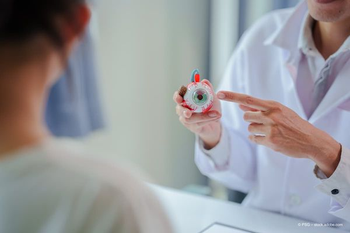
Samsung Bioepis presented a post-hoc analysis of the Phase 3 clinical study results for SB15 at EURETINA 2023
In the data shared, switching to SB15 from AFL maintained comparable clinical efficacy and safety in treating patients with neovascular age-related macular degeneration (nAMD), confirming biosimilarity between these agents before and after switching.
Samsung Bioepis presented a post-hoc analysis of the Phase 3 clinical study results for SB15, a proposed biosimilar to aflibercept (Eylea) at EURETINA 2023 meeting held in Amsterdam, the Netherlands.
The phase 3, randomized, double-masked, parallel-group multicenter study, included 449 participants. These participants were randomized 1:1 to receive 3 monthly intravitreal injections of either 2 mg SB15 or reference aflibercept (AFL) initially, followed by treatment once every 8 weeks up to week 48. According to the company’s press release, the purpose of this post-hoc analysis was to find out biosimilarity between SB15 and reference aflibercept.1
In the data shared, switching to SB15 from AFL maintained comparable clinical efficacy and safety in treating patients with neovascular age-related macular degeneration (nAMD), confirming biosimilarity between these agents before and after switching.
The primary endpoint of this study was change from baseline in best corrected visual acuity (BCVA) at week 8; all endpoints were followed through week 56. The study reported that the efficacy and safety after switching were compared with that of prior to switching. A post-hoc analysis was conducted on efficacy endpoints including change in BCVA and central subfield thickness (CST), using data measured at time of re-randomization at week 32 prior to injection as the new baseline to compare clinical biosimilarity between SB15 and AFL post-switching (AFL/SB15 group vs AFL/AFL group).1
Hyejin Kim, Vice President and Medical and Lifecycle Safety Team Leader at Samsung Bioepis, shared via the press release that the hope of this study is to continue advancing the company’s scientific endeavors while demonstrating safety and efficacy of biosimilars. She said, “we are pleased to present the switching data of SB15 from reference aflibercept that continues to demonstrate its comparable clinical efficacy and safety in treating patients with nAMD. We hope the study results also help allay concerns over safety and efficacy of biosimilars for their use in patients who were previously treated with reference product. We will continue to advance with our scientific research, publication and educational activities to bring more awareness of biosimilars among ophthalmologists.”1
Samsung Bioepis and Biogen announced in November 2019 that they had entered into an exclusive commercialization agreement for two ophthalmology biosimilar candidates, SB11/BYOOVIZ™ (ranibizumab) and SB15 (aflibercept) in major markets around the world.
Mourad Farouk Rezk, Vice President and Head of Global Medical and Development, Biogen Biosimilars Unit, noted that this information is valuable for opthalmologists around the globe. He said, “this post-hoc analysis provides valuable insights on the outcomes of switches from the reference biologic to SB15 and may help clinicians to make well informed decisions on potential use of SB15 if approved.”1`
SB15 Post-hoc Analysis
A total of 449 study participants were randomized 1:1 to receive 3 monthly 0.05 mL intravitreal injections of either 2 mg SB15 or AFL initially, followed by treatment once every 8 weeks up to week 48. At week 32, a total of 438 participants were re-randomized, resulting in 219 continuing SB15, 108 continuing AFL (AFL/AFL), and 111 switched from AFL to SB15 (AFL/SB15). 425 (97.0%) re-randomized participants completed the study up to week 56. The new baseline (W32; prior to re-randomization) characteristics were comparable between the continued (AFL/AFL) group and the switched (AFL/SB15) group. The efficacy was well-maintained post-switching as the mean BCVA letter score (~Snellen equivalent) was 65.3 (20/50) at Week 32 (pre-switching) and 65.8 (20/50) at Week 56 (post-switching) for the AFL/SB15 group compared with 65.2 (20/50) at Week 32 and 65.8 (20/50) at Week 56 within AFL/AFL group. Also, there was no difference in efficacy between the two groups post-switching as the least square (LS) mean for change from W32 in BCVA at week 56 for AFL/AFL was 0.0 letters and 0.2 letters for AFL/SB15 (difference: 0.3 [95% CI: -1.2, 1.8] letters). The LS mean for change from W32 in CST at week 56 for AFL/AFL was -13 μm and for AFL/SB15 was -9 μm (difference: 4 [95% CI: -7, 14] μm). There were no additional safety signals identified and the immunogenicity profile was also similar after switching.1
Reference:
Samsung Bioepis Presents Post-hoc Analysis of Phase 3 Clinical Trial for SB15, a Proposed Biosimilar to Eyleaⁱ (Aflibercept), at EURETINA 2023. Samsung Bioepis Co. Ltd. October 7, 2023. Accessed October 17, 2023. https://www.globenewswire.com/news-release/2023/10/07/2756354/0/en/Samsung-Bioepis-Presents-Post-hoc-Analysis-of-Phase-3-Clinical-Trial-for-SB15-a-Proposed-Biosimilar-to-Eylea%E2%81%B1-Aflibercept-at-EURETINA-2023.html
Newsletter
Keep your retina practice on the forefront—subscribe for expert analysis and emerging trends in retinal disease management.













































